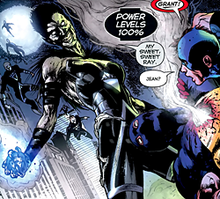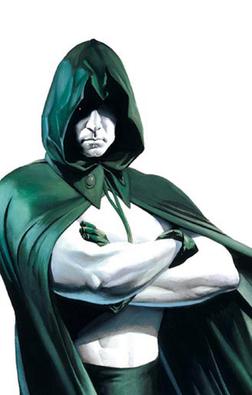
The Spectre is the name of several antiheroes who appear in American comic books published by DC Comics. The original version first appeared in More Fun Comics #52. The character was created by Jerry Siegel and Bernard Baily although some sources attribute creator credit solely to Siegel, limiting Baily to being merely the artist assigned to the feature.
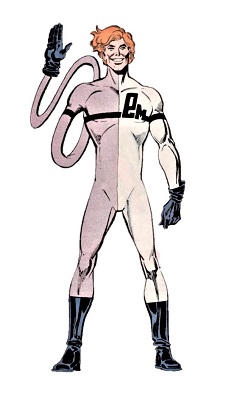
Elongated Man is a superhero appearing in American comic books published by DC Comics. He first appeared in The Flash #112.
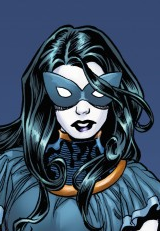
Nightshade is a superhero appearing in media published by DC Comics. Created by David Kaler and Steve Ditko, the character first appeared in Captain Atom #82 originally published by Charlton Comics.

Jade is a superhero in the DC Comics Universe. She first appeared in All-Star Squadron #25 in September 1983. She is the daughter of Alan Scott and Rose Canton and twin sister of Obsidian.
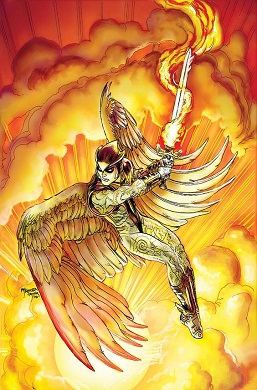
Zauriel is a fictional superhero in the DC Universe. Originally a guardian angel who served Heaven for millions of years, he willingly falls to Earth to serve humanity as their champion and joins the Justice League.
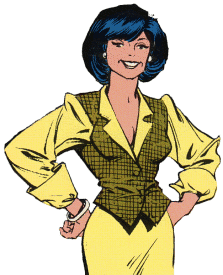
Susan Dibny is a fictional character from DC Comics associated with the Elongated Man. Created by John Broome and Carmine Infantino, the character first appeared in Flash vol. 1 #119. In 2004, she became a flashpoint for discussions of women in comics when a highly controversial storyline was published in which she is murdered and revealed to have been raped by Doctor Light in the past.
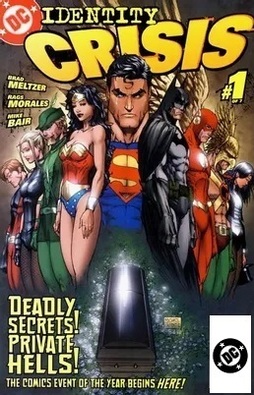
Identity Crisis is a seven-issue comic book limited series published by DC Comics from June to December in 2004. It was created by writer Brad Meltzer and the artistic team of penciler Rags Morales and inker Michael Bair.

Eclipso is a supervillain in American comic books published by DC Comics. Created by Bob Haney and Lee Elias, the character would first appear in House of Secrets #61. The character bears notable similarities to Dr. Jekyll and Mr. Hyde.

Damage is the name of two fictional characters appearing in comic books published by DC Comics.

Day of Vengeance is a six-issue comic book limited series written by Bill Willingham, with art by Justiniano and Walden Wong, published in 2005 by DC Comics.

Mera is a superheroine appearing in American comic books published by DC Comics. Created by Jack Miller and Nick Cardy, the character first appeared in Aquaman #11.
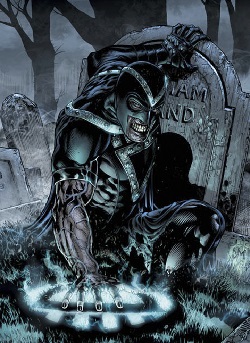
Black Hand is a supervillain and a recurring foe to Green Lantern.

The Atom is a superhero appearing in American comic books published by DC Comics. The character was created by editor and co-plotter Julius Schwartz, writer Gardner Fox and penciler Gil Kane. The Atom was one of the first superheroes of the Silver Age of Comic Books and debuted in Showcase #34.

Hawkman is a superhero appearing in American comic books published by DC Comics. He is the first character to use the name Hawkman. There are two separate origins of Carter Hall; the Golden Age origin and the Post-Hawkworld origin.

Caroline "Carol" Ferris is a fictional character appearing in the DC Comics Universe. She is one of many characters who has used the name Star Sapphire, and was the long-time love interest of Hal Jordan, the Silver Age Green Lantern. In her role as Star Sapphire, Ferris has been active as both a supervillain and, more recently, as a superhero. Her original design was based on Elizabeth Taylor.

Hawkgirl is a superheroine appearing in American comic books published by DC Comics. She was created by writers James Robinson and David S. Goyer and artist Scott Benefiel, and first appeared in JSA: Secret Files and Origins #1.

Nekron is a supervillain appearing in comic books published by DC Comics, primarily as an enemy of the Green Lantern Corps. Created by Mike W. Barr, Len Wein and Joe Staton, the character, who exists as an embodiment of Death, first appeared in Tales of the Green Lantern Corps #2. He is the primary antagonist in the 2009-2010 Blackest Night storyline.

The Black Lantern Corps is a fictional organization of corporeal revenants appearing in comic books published by DC Comics, related to the emotional spectrum. The group is composed of deceased fictional characters in zombie form that seek to eliminate all life from the DC Universe.

"Blackest Night" is a 2009–10 American comic book crossover storyline published by DC Comics, consisting of an eponymous central miniseries, written by Geoff Johns and penciled by Ivan Reis, along with a number of tie-in issues. Blackest Night involves Nekron, a personified force of death who reanimates deceased superheroes and seeks to eliminate all life and emotion from the universe. Geoff Johns has identified the series' central theme as emotion. The crossover was published for eight months as a limited series and in both the Green Lantern and Green Lantern Corps comic titles. Various other limited series and tie-ins, including an audio drama from Darker Projects, were published.

The White Lantern Corps is a fictional organization appearing in comics published by DC Comics, related to the emotional spectrum.




